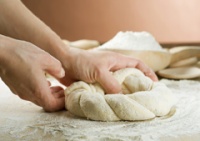Challah
From Halachipedia
Revision as of 14:42, 28 November 2014 by YitzchakSultan (talk | contribs) (→Amount of dough necessary)
There is an obligation for both men and woman to separate Challah from any dough-like batter which they make. The specifics are discussed below.
General Guidelines
- The Mitzvah of removing Challah is only Biblical in Israel and when majority of Bnei Yisrael reside in Israel. There is nonetheless a Rabbinic Mitzvah of Challah outside Israel and in Israel when there is a minority of Bnei Yisrael in residence there. [1]
- It must be stressed that the Mitzvah of Challah applies to all doughs, not just "Challah Bread"; even dough for baking pastries can be obligated in Challah [2].
Conditions for Being Obligated in Challah
- Any dough made from the 5 grains is obligated in the Mitzvah of Challah. [3]
- If the dough or a part of the dough is going to be baked one should separate Challah with a Bracha, however, if all of it is going to be cooked or fried one should separate Challah without a Bracha.[4]
- If the dough is kneaded with eggs or fruit juice, there is some doubt as to whether one needs to separate Challah; therefore, one should knead into the dough some liquid that is considered a "משקה" [e.g. water, milk, bee's honey, wine, oil], and then one can separate Challah with a Beracha [5].
Who is obligated?
- The Mitzvah of Challah applies to the owner of the Challah who is baking the dough, whether that is a man or a woman. However, the woman has preference over a man in fulfilling this Mitzvah as it is particularly relevant for women.[6]
Amount of dough necessary
- According to Ashkenazim, some say that the Minhag is to remove Challah with a Bracha when making a dough that is 5 pounds or more and remove Challah without a Bracha when making dough that is 3 pounds or more. [7] Others say that the Minhag of Yerushalyim is to take Challah off without a Bracha if the dough is 2.65 pounds (1200 grams) or more and to remove Challah with a Bracha if the dough is 3.67 pounds (1666 grams) or more. [8]
- According to Sephardim, one should take off Challah with a Bracha when making a dough with 3.44 pounds (1560 grams) or more of flour and it is a pious practice to remove Challah without a Bracha when making a dough with 2.65 pounds (1200 grams) or more of flour.[9]However, some say that one should only remove Challah with a Bracha for dough that is 5.29 pounds (2400 grams) and without a Bracha for dough that is 3.67 pounds (1666 grams).[10]
- It is forbidden to intentionally make less than the minimum amount of dough which would obligate one to separate Challah. However, if one only has a smaller dough, one needn't worry about making less than the minimum amount.[11]
- If one makes less than the amount required in Challah in separate loaves, but then puts them back into the same vessel--the vessel combines these pieces to make a Shi'ur of Challah [12].
Procedure of removing Challah
Forgot to Remove Challah
Sources
- ↑ Rambam (Bikkurim 5:5-6) writes that The Mitzvah of removing Challah is only Biblical in Israel and when majority of Bnei Yisrael reside in Israel. There is nonetheless a Rabbinic Mitzvah of Challah outside Israel and in Israel when there is a minority of Bnei Yisrael in residence there. The Mitzvah of Challah is counted as one of the 613 mitzvot by the Rambam (Sefer HaMitzvot Asin #133) and Sefer HaChinuch (385).
- ↑ R. Shechter, http://www.yutorah.org/lectures/lecture.cfm/802895/Rabbi_Hershel_Schachter/Inyonei_Challah
- ↑ Kitzur S"A 35:1
- ↑ Kitzur S"A 35:6
- ↑ Kitzur S"A 35:7
- ↑ Mishna (Shabbat 2:6), Kitzur S"A 35:8, Yalkut Yosef YD 328:12
- ↑ S"A YD 324:1 and Kitzur S"A 35:1 write that the amount necessary in order to be obligated in Challah is 43.2 KeBaytzim of flour.Rabbi Hershel Schachter on yutorah.org (Shiur on Parshat Shalach, min 50) states that the Ashkenazic Minhag is to remove Challah with a Bracha if the dough is 5 pounds or more and without a Bracha if the dough is 3 pounds or more.
- ↑ Halichot Shlomo (Moadim vol 2 pg 338 note 54) writes that this was the Minhag in Rav Shlomo Zalman’s house and that of Yerushalyim.
- ↑ Yalkut Yosef YD 324:6
- ↑ Rav Modechai Eliyahu (comments on Kitzur S"A 35:2
- ↑ Yalkut Yosef YD 324:7
- ↑ Mishna Challah 2:4, Kitzur S"A 35:3; See Pesachim 46a-b
- ↑ Kitzur S"A 35:1
- ↑ Kitzur S"A 35:1
- ↑ Kitzur S"A 35:9
- ↑ ibid.
